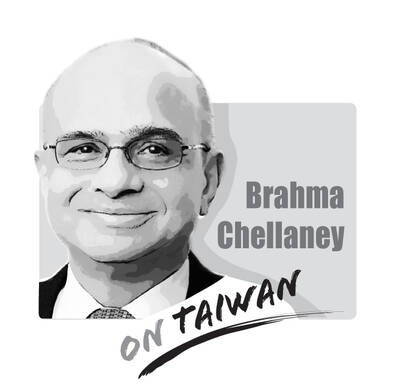The Central Epidemic Command Center (CECC) on Wednesday announced an expansion of the second COVID-19 vaccine booster shot program, doubling the number of eligible groups to eight. Previously eligible were people aged 65 or older, long-term care facility residents, immunocompromised adults and healthcare workers. Since the expansion, which started on Friday, workers at harbors, airports and quarantine and social welfare facilities can also get their fourth dose. The expansion seeks to protect people at risk of having contact with imported COVID-19 cases, the center said, citing a 28 percent increase in imported cases last week, including cases of the Omicron subvariants BA.4 and BA.5 of SARS-CoV-2, amid eased border controls.
The CECC in May recommended additional booster shots for older people, long-term care facility residents and immunocompromised adults, saying they would reduce the risk of servere illness and death, while on Wednesday it said that the other five groups should consider a fourth booster shot depending on their individual risk assessment.
Vaccination rates have been increasing since a local COVID-19 outbreak started in April. In the past few weeks, public debate increasingly focused on whether people should get a second booster and why not everyone is eligible. While most experts agree that a third dose significantly enhances immune protection, which wanes within months of the first two shots, it is less clear whether a fourth dose is necessary.
When the US Food and Drug Administration in March introduced second booster shots for immunocompromised people and people over 50, the agency said that there were no new safety concerns, citing data from Israel, where the safety of second booster doses of the Pfizer-BioNTech COVID-19 vaccine had been studied on 700,000 recipients, including 600,000 people aged 60 or older. However, a larger-scale study in Israel showed that a second booster dose’s additional protection against infection began to wane just four weeks after it was given and no additional protection could be measured after eight weeks, while additional protection against severe illness was still significant after six weeks.
The European Centre for Disease Prevention and Control in late April said: “Public health benefit of administering a second booster dose is clearest in populations aged 80 years and older.” If the virus were to continue to circulate widely, older people should get a second booster shot immediately, it said, adding that whether younger people should get it depends on longer-term trends.
A report by the WHO in May reviewed seven studies on second booster dose rollouts — six from Israel and one from Canada. It concluded that there is “some short-term benefit of an additional booster dose of mRNA vaccine in health workers, those over 60 years of age or with immunocompromising conditions.” It added that “data to support an additional dose for healthy younger populations are limited” and that “in younger people, the benefit is minimal.”
However, some Taiwanese who are eligible for the second booster dose are still concerned about its safety and effectiveness, and wonder whether they should wait for the rollout of next-generation, Omicron-specific vaccines. Local experts on Chinese-language media or social media have urged people at high risk to immediately get a second booster shot, saying that they offer extra protection against severe illness and death from COVID-19.
Meanwhile, the CECC has not done much to promote them. Although the course of the pandemic is hard to predict, and Pfizer and Moderna last month released trial data on their Omicron-specific jabs, the CECC should do more to help people decide whether they should get their fourth shot now or later.
Recently, China launched another diplomatic offensive against Taiwan, improperly linking its “one China principle” with UN General Assembly Resolution 2758 to constrain Taiwan’s diplomatic space. After Taiwan’s presidential election on Jan. 13, China persuaded Nauru to sever diplomatic ties with Taiwan. Nauru cited Resolution 2758 in its declaration of the diplomatic break. Subsequently, during the WHO Executive Board meeting that month, Beijing rallied countries including Venezuela, Zimbabwe, Belarus, Egypt, Nicaragua, Sri Lanka, Laos, Russia, Syria and Pakistan to reiterate the “one China principle” in their statements, and assert that “Resolution 2758 has settled the status of Taiwan” to hinder Taiwan’s
Singaporean Prime Minister Lee Hsien Loong’s (李顯龍) decision to step down after 19 years and hand power to his deputy, Lawrence Wong (黃循財), on May 15 was expected — though, perhaps, not so soon. Most political analysts had been eyeing an end-of-year handover, to ensure more time for Wong to study and shadow the role, ahead of general elections that must be called by November next year. Wong — who is currently both deputy prime minister and minister of finance — would need a combination of fresh ideas, wisdom and experience as he writes the nation’s next chapter. The world that

Can US dialogue and cooperation with the communist dictatorship in Beijing help avert a Taiwan Strait crisis? Or is US President Joe Biden playing into Chinese President Xi Jinping’s (習近平) hands? With America preoccupied with the wars in Europe and the Middle East, Biden is seeking better relations with Xi’s regime. The goal is to responsibly manage US-China competition and prevent unintended conflict, thereby hoping to create greater space for the two countries to work together in areas where their interests align. The existing wars have already stretched US military resources thin, and the last thing Biden wants is yet another war.
As Maldivian President Mohamed Muizzu’s party won by a landslide in Sunday’s parliamentary election, it is a good time to take another look at recent developments in the Maldivian foreign policy. While Muizzu has been promoting his “Maldives First” policy, the agenda seems to have lost sight of a number of factors. Contemporary Maldivian policy serves as a stark illustration of how a blend of missteps in public posturing, populist agendas and inattentive leadership can lead to diplomatic setbacks and damage a country’s long-term foreign policy priorities. Over the past few months, Maldivian foreign policy has entangled itself in playing